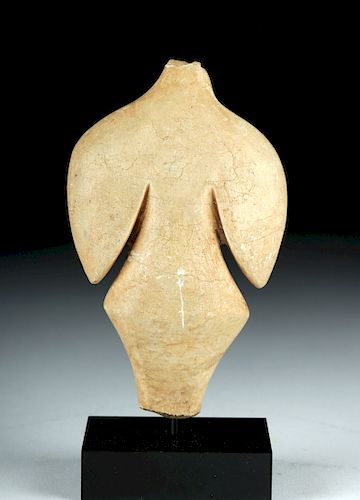Important Anatolian Kilia Marble Idol Body
Lot 92a
About Seller
Artemis Gallery
686 S Taylor Ave, Ste 106
Louisville, CO 80027
United States
Selling antiquities, ancient and ethnographic art online since 1993, Artemis Gallery specializes in Classical Antiquities (Egyptian, Greek, Roman, Near Eastern), Asian, Pre-Columbian, African / Tribal / Oceanographic art. Our extensive inventory includes pottery, stone, metal, wood, glass and textil...Read more
Estimate:
$10,000 - $15,000
Absentee vs Live bid
Two ways to bid:
- Leave a max absentee bid and the platform will bid on your behalf up to your maximum bid during the live auction.
- Bid live during the auction and your bids will be submitted real-time to the auctioneer.
Bid Increments
| Price | Bid Increment |
|---|---|
| $0 | $25 |
| $300 | $50 |
| $1,000 | $100 |
| $2,000 | $250 |
| $5,000 | $500 |
| $10,000 | $1,000 |
| $20,000 | $2,500 |
| $50,000 | $5,000 |
| $100,000 | $10,000 |
| $200,000 | $20,000 |
About Auction
By Artemis Gallery
Feb 21, 2019
Set Reminder
2019-02-21 10:00:00
2019-02-21 10:00:00
America/New_York
Bidsquare
Bidsquare : Exceptional Antiquities, Asian, Ethnographic
https://www.bidsquare.com/auctions/artemis-gallery/exceptional-antiquities-asian-ethnographic-3858
An important one-day auction featuring museum-worthy examples of Egyptian, Greek, Roman, Etruscan, Near Eastern, Far East / Asian, Pre-Columbian, African / Tribal, Oceanic, Native American, Spanish Colonial, Russian, Fossils, Ancient Jewelry, Fine Art, so much more! Artemis Gallery info@artemisgallery.com
An important one-day auction featuring museum-worthy examples of Egyptian, Greek, Roman, Etruscan, Near Eastern, Far East / Asian, Pre-Columbian, African / Tribal, Oceanic, Native American, Spanish Colonial, Russian, Fossils, Ancient Jewelry, Fine Art, so much more! Artemis Gallery info@artemisgallery.com
- Lot Description
Western Asia, Anatolia, Early Bronze Age II, ca. 2700 to 2400 BCE. A creamy brown marble idol of the kilia (kiliya) variety from the Cycladic sculptural tradition, with the rare body remaining (rather than the head, which is more commonly found). The body is roughly triangular in shape, with deep, narrow cuts forming the wide arms and giving the impression of a narrow waist and wide hips. The body tapers from the hips down to a conical single leg. Kilia are highly stylized female figures made throughout the Mediterranean during the Chalcolithic and Early Bronze Age. They are characterized by bulbous heads, long necks, and flat bodies with wide, flipper-like arms. When first made, their faces would have had painted details like eyes, but the bodies do not seem to have been painted. Comes with custom stand. Size: 2.6" W x 4" H (6.6 cm x 10.2 cm); height on stand: 4.9" (12.5 cm)
Votive idols like this one are known in a variety of fascinating forms throughout the pre-literate ancient world. From this truly abstract kilia figure to the exaggerated feminine shapes of so-called "Venus" figures, people in the past, as today, had a clear desire to portray human forms and did not feel constrained by naturalism. Figures like these seem to be portraying worshippers rather than gods, and we believe that they were small enough that ordinary people could have owned them and kept them on home altars. Still others are found clustered in temples.
Provenance: private Swiss collection
All items legal to buy/sell under U.S. Statute covering cultural patrimony Code 2600, CHAPTER 14, and are guaranteed to be as described or your money back.
A Certificate of Authenticity will accompany all winning bids.
We ship worldwide and handle all shipping in-house for your convenience.
#124123Piece is a fragment, with patina from touch and age. Head and base are ancient losses.Condition
- Shipping Info
-
All shipping is handled in-house for your convenience. Your invoice from Artemis Gallery will include shipping calculation instructions. If in doubt, please inquire BEFORE bidding for estimated shipping costs for individual items.
-
- Buyer's Premium



 EUR
EUR CAD
CAD AUD
AUD GBP
GBP MXN
MXN HKD
HKD CNY
CNY MYR
MYR SEK
SEK SGD
SGD CHF
CHF THB
THB














